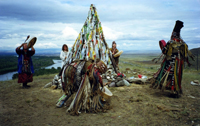Shamans of Siberia, including Tuva – Magicians, Intermediaries, Healers: An outstanding exhibition in Stuttgart, Germany, from December 13, 2008 to June 28, 2009 |
|
 |
|
Kamlanie in Tuva - shamanic ceremony for the erection of a place of sacrifice 2007 in Tuva - photo by Vera Charitonova |
The renowned Linden-Museum in cooperation with the Museum of Ethnography in St. Petersburg is presenting this outstanding and lively exhibition at a time when Germans remain sensitive and open-minded for Siberian cultures and art forms thanks to the large Scythian exhibitions in Berlin, Munich and Hamburg in 2007 and 2008. Siberia has been and is known here as a huge land of diverse climates and extraordinary landscapes. At the same time its widely unknown wilderness and the many fascinating cultures of its indigenous peoples have always attracted researchers and visitors to learn more about that part of the world. This impressive exhibition in Stuttgart highlights the ancient belief systems of Siberian people to deal with the world beyond. In their peoples’ view, spirits choose humans to become shamans to act in altered states of mind as intermediaries between the spirit realm and the human world in times of anxiety and crisis.
 |
|
Shaman from Tuva - photo by Ulrike Bohnet |
The exhibition relates to individual shamans who had lived around the turn to the 20th century. Their costumes and their regalia, such as their drums, are being shown. Their songs and practices are depicted in special multimedia installations. Furthermore, contemporary artists show their works that deal with the shamanic ideas and motifs. In this unique exhibition the Linden-Museum and the Museum of Ethnography present more than 200 of the most intriguing and outstanding objects worldwide on this theme for the first time in Germany.
 |
|
The ensemble Tyva Khogzhum performed at the exhibition's grand opening - photo by Olchei Booking |
A multi-faceted program is complementing the exhibition with dance performances by artists from Siberia, film events and workshops, as well as highlighting musical art, such as by Tyva Khogzhum. This ensemble – consisting of Kara-Kat Soyan, Otkun Dostai (who has for several years also performed together with Sainkho Namtchylak), and of Choduraa Tumat, one of the female pioneers of throatsinging – is known for researching the musical culture of Tuva and for locally passing on the old traditions to the young generation. Tyva Khogzhum is also touring many countries to introduce the famous Tuvan throatsinging to audiences abroad. The ensemble is also well known for its ability to present the entire spectrum of traditional music forms including contemporary musical trends that originate in Tuva.
Other program aspects of the exhibition include “Story telling from the steppe and the taiga: Of shamans and reindeer herders”, it also includes workshops such as to produce and craft pieces of art for decoration, adornment and the like from natural materials such as tree barks, as well as featuring lectures by prominent European researchers on “Nomads between today and tomorrow” and other subjects of interest.
Over the Christmas season, there has been an astonishingly strong flow of adult visitors and of families. Special programs for schoolclasses and children add towards the attractiveness of this great Siberian exhibition, which will also heighten the German attention towards Tuva.
For further details visit the museum’s website http://www.lindenmuseum.de/. The book with DVD “Geheimnisvolles Tuwa – Expeditionen in das Herz Asiens” by the late Sev’yan I. Vainshtein is sold during this exhibition and is featured on the website http://www.alouette-verlag.de/.
|
|
